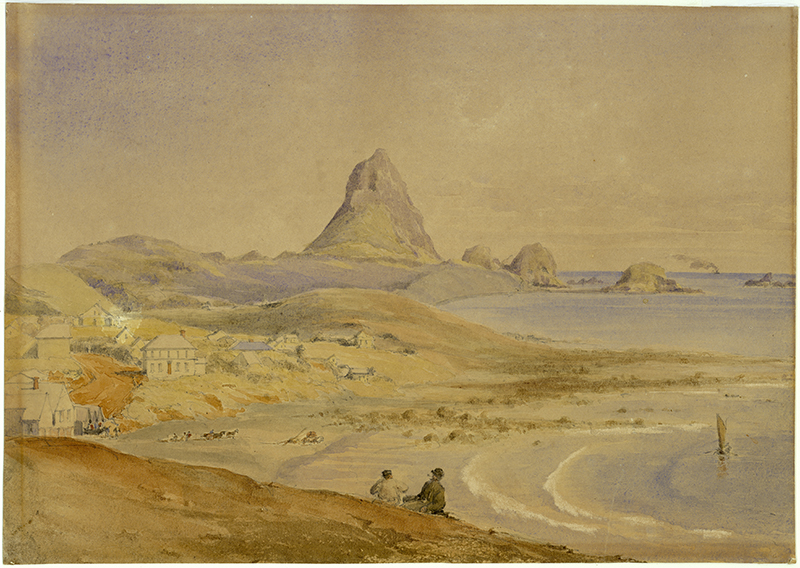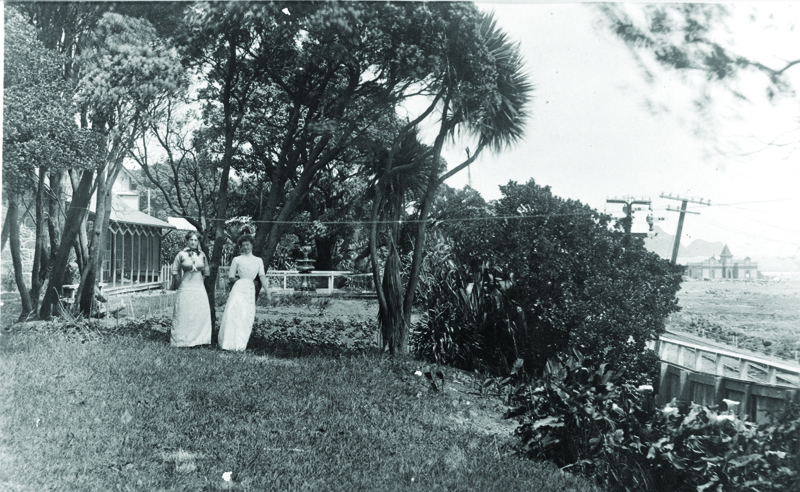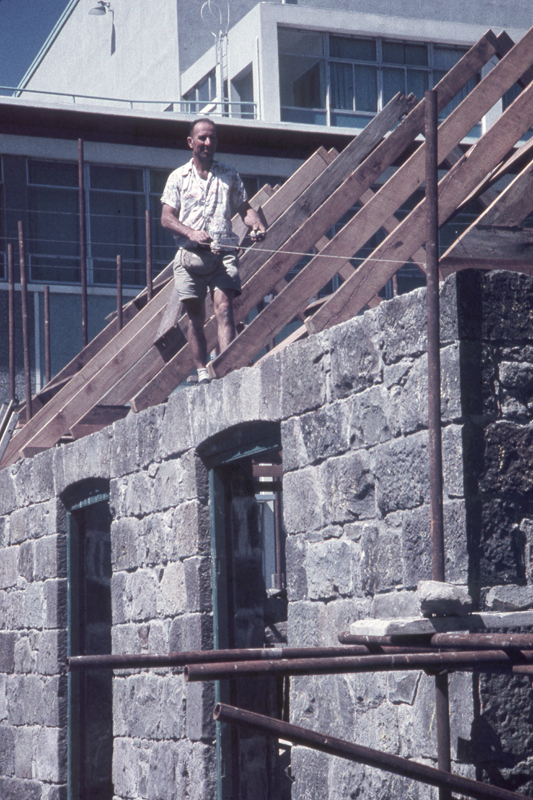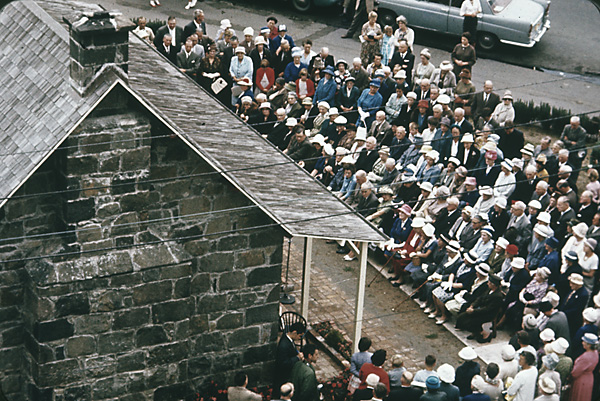







A stone cottage sits like a doll's house under the wing of a giant building. The house is Richmond Cottage, built by an English pioneer family 150 years ago. The huge two-wing structure is Puke Ariki. Both tell stories of Taranaki's heritage.
Piecing together the history of Richmond Cottage is as complicated as assembling the house itself, block by block, a feat completed twice in the building's lifespan. The first time was in 1853 and 1854, when it was built as a home for lawyer William Richmond, his new wife Emily (nee Atkinson) and their first-born, Mary Elizabeth. They were among the last of the inter-linked, middle-class Richmond, Hursthouse and Atkinson families to sail to New Zealand.
The Mob as they were called, arrived in Taranaki in dribs and drabs. Leading the way in 1842 were John and Helen Hursthouse (nee Wilson), with their children. That first party also included John's brother, Charles Flinders Hursthouse, and a Norwich friend, John Newbegin, whose surname described all their hopes.
On 1 August 1842, they left an England rife with unemployment, disease and poverty. It was an eventful journey on the Thomas Sparks. As the 498-ton ship entered Table Bay, South Africa, it hit a rock and was nearly wrecked. Luckily, the damaged vessel managed to slink into Cape Town for a two-month repair stop. After all was shipshape, the Thomas Sparks again set out for New Zealand, sailing into Port Nicholson, Wellington, on 31 January 1843. There, John heard a glowing account of Taranaki and so the Hursthouse clan moved to the bump on the west coast of the North Island. They bought semi-cleared farmland on the outskirts of New Plymouth and got to work.
While Helen found settler life tough, John was hugely enthusiastic about Taranaki, as was Charles Hursthouse on his return to England in 1850. The Richmonds listened to Charles's exaggerated claims of a grand life in the colonies, drew their own conclusions and began making plans for a better life in the Southern Hemisphere.
Maria Richmond (nee Wilson), sister to Helen Hursthouse, was the matriarch of the Richmond family and a widow in a financially anxious state. Lely, as she was known, had done her best on limited means, but saw New Zealand as a chance for a fresh start. Therefore, it was decided that her two youngest sons, James Crowe (then 28) and Henry Robert (then 21) would follow their Hursthouse relations to the ends of the Earth.
The plan was for the Richmond brothers to establish a home in Taranaki and then send for their mother, elder brother, (Christopher) William, and their unmarried sister, (Jane) Maria.
On 3 October 1850, the young men left Gravesend, England, on the Victory. They landed in Auckland on 7 February 1851 and then walked to Taranaki. They found their way through the Waikato and Kāwhia with the paid help of three Māori guides.
Beneath Mount Taranaki, the young Richmond men bought land for dairy farming in an area they called Hurworth on Carrington Road. "The country is by no means romantically beautiful, that is without the mountain" Henry wrote. "But when he is visible, I can hardly take my eyes of him, he is so very beautiful."
Back in England, the Great Exhibition of 1851 turned the world's eyes on London. And love was in the air, with the first of the Richmond-Atkinson unions formed. The serious-minded William Richmond and the “frank, generous” Emily Atkinson were married on 15 September 1852. A few months later, the newlyweds, plus Lely, Jane Maria, and the Atkinson brothers, Harry and Arthur, along with Lely's nephews, Charles and Calvert Wilson, boarded the Sir Edward Paget.
The ship sailed from Gravesend on 9 December 1852, but was waylaid by stormy English waters. The 481-tonne ship was anchored at the Isle of Wight for five weeks, until the seas calmed down. Despite the hold-up, the long voyage bore fruit. Emily Richmond became pregnant and Jane Maria and Arthur Atkinson fell in love. She was 28 and he was 19.
On 25 May 1853, the Sir Edward Paget sailed into Auckland. William, Emily and Lely stayed on board for two months, waiting for the ship's passage to New Plymouth. But Maria, along with Arthur and Harry Atkinson were impatient to go south as soon as possible. They secured cabins aboard a small schooner, The Sisters, and arrived off New Plymouth on 18 June.
Finally, we have come to the beginnings of Richmond Cottage, a name given to the building more than a century later. Its founders called it Beach Cottage. It is believed that James Crowe Richmond bought the seafront section by proxy in 1841. However, records of this sale have not been found.
More details are known about the building of the cottage and its exact location. Maps show the cottage was built on the northern side of St Aubyn Street, on the exact spot where the multi-storeyed Richmond Estate apartment building now stands. While no longer on that site, the rest of the cottage is the real thing. The original stone blocks that form its walls are hewn andesite. This is the same type of volcanic rock shaped by sculptors in the Te Kupenga stone sculpture symposium held on New Plymouth's foreshore biannually in the summertime.
Back in 1853, stonemason Nathaniel Hooker mined his stone from the Kawaroa reef. While he did the rock work, Henry Richmond, Arthur Atkinson and a friend called William Crow did the rest. The plan was to have the house ready by September for Emily to have her baby. "A push is being made to prepare the marine villa for her reception at that time, but… there is difficulty in getting a sufficient supply of shingles for roofing at once and the internal fittings cannot proceed far till the roof is on" wrote Jane Maria on 24 July 1853.
"The beach house will be lined with red pine (rimu) wood. I like the appearance of this wood very much. The roof will be open showing the rafters ..." Mary Elizabeth Richmond was born on 30 August, easily beating the cottage's completion deadline. In fact, the family didn't move in until the following year. When it was finished, it was deemed to be worth £150 and considered one of the most elegant buildings in New Plymouth.
William, Emily, baby Mary, Anna Wilson (born 1855) and Lely (William's mother) lived in the cottage until he was elected to represent New Plymouth in the General Assembly at Auckland in 1856. Lely didn't stay at the cottage, which was then rented out to a Major Mark Matthews, paymaster of the 57th Regiment. The much-loved matriarch divided her time between Auckland and New Plymouth.
In Taranaki, she lived at Hurworth with Jane Maria and her husband, Arthur Atkinson. They were married in 1855, a year of events. As well as sealing their love, they also climbed mountains. One actually - the beauty they called Mount Egmont (Mount Taranaki) on 7 March. This feat put Jane Maria in the history books as the first Pākehā woman to reach the summit of the mountain.
They also felt the earth move. On 23 January they experienced a severe earthquake that caused considerable damage and loss of life in Wellington. In New Plymouth, Beach Cottage felt it in its stones, but was unmoved.
In 1860, The Mob was on the move. After the Taranaki Wars began at Waitara on 17 March that year, many women and children fled to the safety of Nelson in the upper reaches of the South Island. Suffering from flu, Jane Maria packed up her family home and moved to Auckland to join William and Emily.
When the families returned to Taranaki and Carrington Road in May 1862, they found only one building still standing - the home now called Hurworth Cottage. The rest were burnt down during the conflict.
So, Arthur, Jane Maria and children moved into Beach Cottage, their last home in Taranaki. Lely, who moved in with the Atkinsons soon after, wrote: "I never appreciated the situation of the cottage as I do now - the little bit of greenery in front, thought the garden has run wild, between you and the sea, is a great relief to the eye ... I hope it will never go out of the family again ... unless we are all permanently driven out of Taranaki."
In August 1863, Lely bought Beach Cottage off William for £500. During the politically unsettled 1860s, Beach Cottage proved to be a safe haven from the Wars, a place of recovery from illness and a nursery for Jane Maria's children and other youngsters she cared for. "This is a most blessed house for sickness, opening the windows here is equal to talking a walk" wrote Jane Maria, after her household fought off scarlet fever.
Other members of the family weren't so lucky in Nelson. In 1864, Henry Richmond's first wife, Blanche Hursthouse, died and the following year so did James Richmond's wife, Mary Smith. Lely died in 1868, the same year the Atkinsons left Beach Cottage for Nelson, and Henry remarried. He and his new wife, Emma Jane Parris, moved into the New Plymouth beachfront home in 1872.
The following year, the cottage became a place of learning. Henry set up a school that was attended by boys destined to great things. Among those pupils were Newton King, who became a successful Taranaki businessman, his brother Truby King, who founded the Plunket Society and William Henry Skinner, who became a well-known historian.
Henry, who was mad-keen on science, conducted lessons that included experiments with iron sand from the foreshore at New Plymouth. Eventually, Henry became a student himself, following his brother William into law. At the end of 1890, the youngest of the three Richmond brothers died in Christchurch. He was on his way to Dunedin to consult with one of his former pupils, Dr Truby King, when he collapsed. It was thought he may have had a brain tumour. This brought a close to The Mob's hold on Beach Cottage.
Sometime in the early 1880s, it became an offshoot of Terminus Hotel and was used as motel units from then until about 1914. It was then used as staff quarters for the hotel and later rented out. Details about those times are sketchy.
In 1961, Taranaki Breweries Ltd, which owned the cottage, had plans to build a towering hotel overlooking the Tasman Sea. But there was one hindrance - the old homestead was in the way. When plans were announced to pull down the old Richmond home, the residents of New Plymouth rallied to save it. Convener of the Richmond Cottage Preservation Committee was female city councillor Audrey Gale. She led the campaign to preserve this piece of colonial history and won.
On 15 May 1961, the New Plymouth City Council agreed to provide £500 towards moving the cottage, block by block, to a new site. But there was a proviso - the community had to raise funds towards the project. The Taranaki Herald, with historian Brian Scanlan at the helm, backed the fundraising campaign and even published the details of donations. Relatives of The Mob, by then scattered all over New Zealand, gave money.
As well as the council's £500, donations came from the New Zealand Historic Places Trust, Bank of New Zealand and private citizens. A total of £2100 was gathered towards the relocation - but where to?
There were two schools of thought. Some people believed the cottage should be moved alongside The Gables at Brooklands in an endeavour to form a nucleus of a New Zealand Williamsburg (a preserved pioneer settlement in the United States). Others wanted it moved to a piece of ground on the corner of Ariki and Brougham Streets.
The central option was considered more practical because the stone home would be close to the Taranaki Museum and its central location would be ideal for tourism. Despite pleas from the Historic Places Trust to keep the cottage in its original seafront position, demolition began.
For stonemason Mr J.R. Bird the job was a giant jigsaw puzzle. Each block had to be numbered and dozens of photos taken before the cottage was pulled down. As it was dismantled, Mr Bird discovered the mortar between the stone blocks was crumbling, but the walls were still sturdy. He believed they would “have lasted for a few hundred years yet”.
When the wall lining of the cottage was removed, workmen found a torn sheet of an old Auckland newspaper, with a report on the wreck of the Culgoa when she was leaving Hokianga Harbour on September 1866. Nearly 100 years later, there was another minor mishap with rocks - this one at Richmond Cottage.
In October 1961, Mr Bird fell from scaffolding while removing a huge stone block, which became unbalanced. The heavy stone crashed down, snapping a thick scaffolding plank and bending the scaffolding. Mr Bird fell and gashed his chin, which required two stitches. "I was lucky I didn't break my teeth or cut my tongue" he told a local newspaper. He was back on the job a few days later.
The cottage was pulled down in 1961 and rebuilt in 1962, with gaps in the stonework filled using blocks from the demolished Australia and New Zealand Bank at the corner of Currie and Devon Streets. Finally, the building was ready for its new life as a colonial museum. Other uses had been considered, but this purpose was deemed the most appropriate.
On hand to formally open the newly named Richmond Cottage was a man whose life began within its walls.
Howard Parris Richmond, the son of Henry and Emma, was born there exactly 85 years before, on 30 March 1878. Talking to the Taranaki Herald in 1963, Howard spoke of the days when the cottage was by the sea, only separated from the beach by a flax hedge. At that time, New Plymouth was a ramshackle town. "He recalled walking to town with his grandfather, Major Robert Parris, who spoke fluent Māori to the natives as they walked," the newspaper said. Howard said the cottage was originally built for his uncle, William Richmond, a member of the Cabinet who later became a Supreme Court judge. Howard also became a lawyer and in 1951 was made a QC. He retired about 1955 and died on 12 January 1974, aged 95.
When the cottage opened as a museum in 1963, it was filled with artefacts donated by the Richmond family and other Taranaki people. In the first 12 months after reopening, more than 10,000 people paid admission to investigate the cottage, which was owned by the city council and administered by the then Taranaki Museum.
Outside, the garden was planted in an English-style garden from the 1850s. This featured a front hedge of rosemary and glorious roses which, one dark night in the 1970s were stripped bare of petals by teenagers intent on making rose-petal wine.
In October 1985, the Taranaki Museum's executive committee sought public submissions for possible use of the cottage for commercial purposes. By February 1986, the committee had received three applications to use the cottage. They came from an antique dealer, a florist and the toy library.
However, then museum director Ron Lambert voiced his concern about the building being used for a commercial venture. The people of the 1960s had intended it to be a tribute to the Richmond and Atkinson families and a record of New Plymouth's early settlement days. And that's how it has been kept - to this very day. On the way there have been more revamps, with ongoing replacement of roof tiles. There have been more debates about what the cottage should or could be used for and public passion has been vented in newspapers about its three-year closure during the building of Puke Ariki.
Hursthouse, C. (1949). An Account of the Settlement of New Plymouth, In New Zealand, from Personal Observation, During a Residence of Three to Five Years. London: Smith, Elder.
New Zealand National Historic Places Trust (1963). The Richmond Cottage. Wellington: Government Printer.
Northcott, D. (1983). Jane Maria.
Porter, F. (1989). Born to New Zealand: a biography of Jane Maria Richmond. Wellington: Allen and Unwin/Port Nicholson Press
Scholefield, G. H. (1960). The Richmond-Atkinson Papers. Wellington: Government Printer
Please do not reproduce these images without permission from Puke Ariki.
Contact us for more information or you can order images online here.